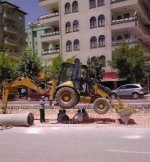RickB
Super Star Member
- Joined
- Sep 18, 2000
- Messages
- 15,190
- Location
- Up the road from Dollar General WNC
- Tractor
- Just a Scag
I never leave the tires on the ground on my 580K. The simple fact is that the stabilizers are steel while the tires are rubber. Rubber flexes while the steel is solid. Secondly the stabilizers will sink into the ground some as you work. If your tires are touching the ground they will get more and more weight transferred to them. You can even mask the problem of soft ground until you swing the backhoe to the side while working with a load and having the stabilizer sink in. If you like bouncing around then by all means leave your tires on the ground.
The idea that it raises the center of gravity making it less stable is completely wrong. Yes your center of gravity is raised some but the footprint is increased. The stabilizers a further back and much wider than the tires. In fact you should be curling your bucket down and the putting that on the ground to raise your front tires off the ground too. Remember that tractors have a front axle that pivots. With the front bucket down you turn a foot print that's the shape of a triangle to a much larger square and more stable square. So while you may have raised the CoG by 6" you've also added several feet in width and a foot or to in length at the rear which more than offsets the higher CoG.
The exception is a CUT with loaded tires. In that case, because of the extra weight, leaving them touching the ground will reduce stress. However, as I said, you need to pay more attention to the stabilizers sinking into the ground.
There is a discernible difference between having the wheels 2 or 4” off the ground and 12-14”.
